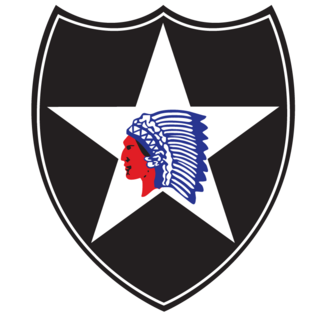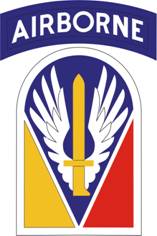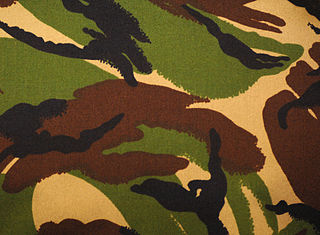
In military organizations, a colour guard is a detachment of soldiers assigned to the protection of regimental colours and the national flag. This duty is highly prestigious, and the military colour is generally carried by a young officer (ensign), while experienced non-commissioned officers are assigned to the protection of the national flag. These non-commissioned officers, accompanied in several countries by warrant officers, can be ceremonially armed with either sabres or rifles to protect the colour. Colour guards are generally dismounted, but there are also mounted colour guard formations as well.

The 2nd Infantry Division ("Indianhead") is a formation of the United States Army. Since the 1960s, its current primary mission is the pre-emptive defense of South Korea in the event of an invasion from North Korea. There are approximately 17,000 soldiers in the 2nd Infantry Division, with 10,000 of them stationed in South Korea, accounting for about 35% of the United States Forces Korea personnel. Denoted the 2nd Infantry Division-ROK/U.S. Combined Division (2ID/RUCD), the division is augmented by rotational Brigade Combat Teams (BCTs) from other U.S. Army divisions.

The 1st Cavalry Division is a combined arms division and is one of the most decorated combat divisions of the United States Army. It is based at Fort Cavazos, Texas. It was formed in 1921 and served during World War II, the Korean War, the Vietnam War, the Persian Gulf War, with the Stabilization Force in Bosnia-Herzegovina, in the Iraq War, in the War in Afghanistan as well as Operation Freedom's Sentinel and Operation Inherent Resolve. As of July 2023, the 1st Cavalry Division is subordinate to III Armored Corps and is commanded by Major General Kevin D. Admiral.

Fort Irwin National Training Center is a major training area for the United States military in the Mojave Desert in northern San Bernardino County, California. Fort Irwin is at an average elevation of 2,454 feet (748 m). It is located 37 miles (60 km) northeast of Barstow, in the Calico Mountains.

The 11th Armored Cavalry Regiment is a unit of the United States Army garrisoned at the Fort Irwin National Training Center in California. The regiment has served in the Philippine–American War, the Pancho Villa Expedition, World War II, the Vietnam War, Gulf War and Iraq War. The 11th ACR serves as the opposing force (OPFOR) for the Army and Marine task forces, and foreign military forces that train at Fort Irwin.

The Air Assault Badge is awarded by the U.S. Army for successful completion of the Air Assault School. The course includes three phases of instruction involving U.S. Army rotary wing aircraft: combat air assault operations; rigging and slingloading operations; and rappelling from a helicopter.

The 81st Readiness Division ("Wildcat") was a formation of the United States Army originally organized as the 81st Infantry Division during World War I. After World War I, the 81st Division was allotted to the Organized Reserve as a "skeletonized" cadre division. In 1942, the division was reactivated and reorganized as the 81st Infantry Division and served in the Pacific during World War II. After World War II, the 81st Infantry Division was allotted to the Organized Reserve as a Class C cadre division, and stationed at Atlanta, Georgia. The 81st Infantry Division saw no active service during the Cold War and was inactivated in 1965.

The 28th Infantry Division ("Keystone") is a unit of the Army National Guard and is the oldest division-sized unit in the Department of Defense. Some of the units of the division can trace their lineage to Benjamin Franklin's battalion, The Pennsylvania Associators (1747–1777). The division was officially established in 1879 and was later redesignated as the 28th Division in 1917, after the entry of America into the First World War. It is today part of the Pennsylvania Army National Guard, Maryland Army National Guard, Ohio Army National Guard, and New Jersey Army National Guard.

The black beret is a colour of beret, a type of headgear. It is commonly worn by paramilitaries and militaries around the world, particularly armored forces such as the British Army's Royal Tank Regiment (RTR), the Royal Canadian Armoured Corps (RCAC), and Royal Australian Armoured Corps (RAAC) and the Indian Army Armoured Corps and Indian Border Security Force. Notable non-armored military units to wear the black beret include the non-military police and non-special forces elements of the Irish Defence Forces, MOD Guard Service, Russian Naval Infantry and Russian OMON units, the United States Air Force (USAF) Tactical Air Control Party (TACP), Philippine National Police-Special Action Force (PNP-SAF) members, and the Royal Canadian Navy. It was also worn by the United Kingdom's Royal Observer Corps (ROC) with their Royal Air Force (RAF) uniform, Metropolitan Manila Development Authority (MMDA).

Fort Johnson, formerly Fort Polk, is a United States Army installation located in Vernon Parish, Louisiana, about 10 miles (15 km) east of Leesville and 30 miles (50 km) north of DeRidder in Beauregard Parish.

The Georgia State Defense Force is a professionally trained, volunteer component of the Georgia Department of Defense, serving in support of the national and state constitutions under direction of the governor and the adjutant general of Georgia. As a State Defense Force (SDF), the GSDF serves alongside the Georgia Army National Guard and the Georgia Air National Guard.

Disruptive Pattern Material (DPM) is the commonly used name of a camouflage pattern used by the British Armed Forces as well as many other armed forces worldwide, particularly in former British colonies.

MultiCam is a camouflage pattern designed for use in a wide range of environments and conditions which was specifically developed and is produced by American company Crye Precision. As a result of the pattern's effectiveness across disparate environments and regions, it has found extensive adoption globally. Variants of it, some unlicensed, are in use with armed forces worldwide, particularly with special operations units.

The reorganization plan of the United States Army was implemented from 2006 to 2016 under the direction of the Brigade Modernization Command. This effort formally began in 2006 when General Peter Schoomaker was given the support to move the Army from its Cold War divisional orientation to a full-spectrum capability with fully manned, equipped and trained brigades; this effort was completed by the end of 2016. It has been the most comprehensive reorganization since World War II and included modular combat brigades, support brigades, and command headquarters, as well as rebalancing the active and reserve components.

The Utah National Guard comprises both Army and Air National Guard components. The Constitution of the United States specifically charges the National Guard with dual federal and state missions. The National Guard is the only United States military force empowered to function in a state status.

The 177th Armored Brigade is an AC/RC unit based at Camp Shelby, Mississippi. The unit is responsible for training selected United States Army Reserve and National Guard units. The unit was formerly designated as 3rd Brigade, 87th Division. The brigade is a subordinate unit of First Army.

Armour is the formation of the Singapore Army responsible for armoured warfare. It provides mobile firepower support and rapid mobility for the Army by helping to spearhead an advance past the enemy defences and seizing and holding key objectives on the battlefield. It has four active battalions—the 40th, 41st, 42nd and 48th Battalions, Singapore Armoured Regiment (SAR)—based in Keat Hong Camp and Sungei Gedong Camp, as well as an undisclosed number of reservist battalions.

The Korea Combat Training Center is a South Korean military training unit for the ROK Army and Marine Corps. It is one of the subordinate elements of the Republic of Korea Army Training & Doctrine Command.

The 221st Cavalry Regiment, Nevada Army National Guard, is a parent regiment under the U.S. Army Regimental System, with headquarters in Las Vegas, Nevada. It currently consists of 1st Squadron, 221st Cavalry Regiment a 600-soldier Armored Reconnaissance Squadron of the Nevada Army National Guard located in southern Nevada. For command and control purposes within the Nevada Army National Guard, 1st Squadron, 221st Cavalry Regiment, is a subordinate unit to the Land Component Commander (LCC) of the Nevada Army National Guard. In 2016, the squadron entered into an alignment-for-training relationship with the 116th Cavalry Brigade Combat Team, 34th Infantry Division. In May 2016, the squadron donned the Shoulder Sleeve Insignia of the 116th Cavalry Brigade Combat Team. As an armored reconnaissance squadron, the 1st Squadron, 221st Cavalry Regiment, is able to deploy three mechanized cavalry troops, one armor company, a support company, a headquarters troop, and a squadron headquarters in order to accomplish its federal, state, and community missions.




















































